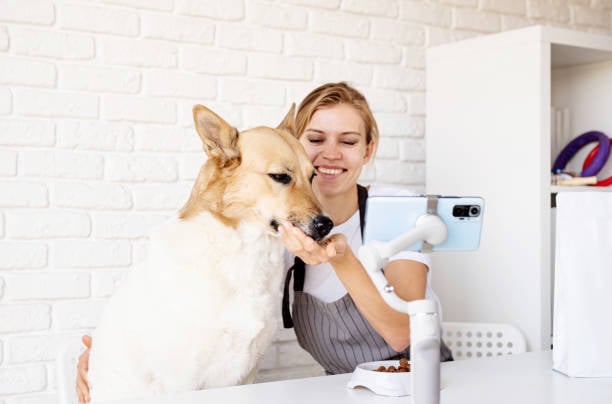Industry Trends Shaping the Global Pet Business Landscape
The pet industry has experienced explosive growth in recent years, and with that growth comes change. The way pet parents engage with services like dog grooming, boarding, training, and even dog parks and bars is evolving. A rise in pet ownership numbers also influences pet-care business trends and drives new opportunities.
As businesses look to stay competitive in a landscape shaped by technology, generational shifts, and growing pet parent expectations, it's important to keep on top of emerging pet industry trends. Several general changes and innovations are impacting the business world, and those in the pet-care space can keep an eye on larger and niche industry trends to ensure they're moving in the right direction.

1. AI Is Transforming the Way Pet-Care Businesses Operate
Artificial intelligence (AI) is no longer just for big tech. From intelligent scheduling to personalized marketing, AI is now making waves in the pet-care industry, driven by recent technological advancements that are transforming how services are delivered.
Dog groomers can use AI to help automate appointment reminders, suggest services based on breed or coat condition, or send seasonal promotions. Boarding facilities can predict peak periods based on historical data and staff accordingly. Even training businesses are tapping into AI to create digital resources or behavior insights.
Why it matters:
According to McKinsey, generative AI could add up to $4.4 trillion annually to the global economy. Pet-care businesses that adopt AI-powered tools will be better positioned to streamline operations and create highly personalized experiences.
How to take action:
- Use AI-enabled software to automate appointment scheduling, reminders, and follow-ups.
- Analyze customer data to offer tailored services, upsells, or loyalty perks.
- Try tools like ChatGPT to help brainstorm content, write emails, or create pet-care guides.
2. Hybrid Work Is Reshaping Pet-Care Demand
With millions of pet parents working hybrid schedules, demand for pet-care services has shifted. Some dogs need care only two or three days a week — while others need flexible drop-ins or last-minute daycare bookings. That unpredictability requires businesses to stay agile and offer flexible scheduling.
Why it matters:
Remote work, as a whole, is up from its pre-pandemic numbers, according to the U.S. Bureau of Labor Statistics. That means doggy daycare, walking, and boarding services need to adjust their hours, staffing, and booking models to match evolving routines. Younger pet owners, in particular, are more likely to seek flexible pet-care options due to their dynamic work schedules.
How to take action:
- Offer part-time daycare packages or flexible training sessions.
- Allow online modifications or cancellations to reduce administrative headaches.
- Adjust staffing models to accommodate midweek peaks and weekend dips.
3. Pet Parents Expect Sustainable Practices
Today’s customers want to know that the businesses they support are minimizing their environmental impact. Whether it’s compostable poop bags, cruelty-free shampoos, or digital paperwork to cut down on printing, sustainability isn’t just a nice-to-have — it’s a selling point.
Why it matters:
Per the Harvard Business Review, over 70% of consumers are more likely to buy from sustainable brands. In pet care, this trend is seen in everything from eco-conscious retail products to how businesses manage waste and water usage. Many pet lovers now prefer products that align with their environmental values.
How to take action:
- Replace printed forms with digital intake and vaccination records.
- Stock retail shelves with locally sourced or sustainable pet products.
- Use biodegradable grooming products and communicate your efforts with signage or social posts.

4. Digital Transformation Is Taking Over
Old-school methods like dry-erase boards, handwritten notes, and phone tag bookings are becoming liabilities in an increasingly tech-driven world. More pet-care businesses are adopting cloud-based platforms to manage operations and deliver a professional, streamlined customer experience.
Why it matters:
Digital transformation is a top priority for small businesses aiming to stay competitive. In pet care, this means automating bookings, tracking staff hours, and streamlining customer communications. Analyzing search volume can also help pet-care businesses identify trending services and optimize their digital offerings based on real-time demand.
How to take action:
- Use digital booking platforms to reduce no-shows and free up your team’s time.
- Implement software that integrates client notes, vaccination tracking, and payment processing.
- Provide mobile-friendly access for clients on the go.
5. Memberships and Subscriptions Create Predictable Revenue
Monthly grooming memberships. VIP dog park passes. Pre-paid training class packs. Subscription-based models are everywhere — and they’re working. These options build client loyalty while providing a more predictable stream of revenue for pet businesses.
Why it matters:
The subscription economy is growing five times faster than traditional retail. Offering memberships can boost retention and increase average client value for pet businesses. Subscription models can also drive revenue growth by encouraging recurring payments and improving client retention.
How to take action:
- Create VIP programs for loyal clients — think unlimited nail trims or priority boarding.
- Offer tiered memberships with perks like exclusive event invites or early access to appointments.
- Use software with built-in recurring billing to manage renewals and payments.
6. The Creator Economy Comes to Pet Care
Pet-care professionals — especially dog trainers and groomers — are becoming creators and influencers. From TikTok grooming reveals to Instagram training tips, content is building trust, educating pet parents, and even attracting new clients with entertaining content that's relevant to their interests (read: cute dogs).
Why it matters:
The creator economy is a $100+ billion industry, and pet-care businesses are perfectly positioned to tap in. Authentic, behind-the-scenes content builds stronger relationships and spreads the word faster than ads ever could.
How to take action:
- Film simple videos showing your grooming process, staff intros, or facility tours.
- Create content around trending topics in the pet industry to attract more engagement.
- Encourage happy clients to tag your business and share their experiences.

7. Cybersecurity and Data Privacy Are Non-Negotiable
From customer payment information to pet vaccination records, pet-care businesses handle a surprising amount of sensitive data. With more operations moving online, protecting that data is critical—not just for compliance but also for trust.
Why it matters:
The World Economic Forum ranks cyber threats as one of the biggest risks to global business. Even small businesses aren’t immune — and a data breach can damage both reputation and revenue.
How to take action:
- Use secure, cloud-based software with strong encryption and automatic backups.
- Create staff policies around password protection and device access.
- Regularly review privacy settings, access levels, and vendor security protocols.
8. Gen Z & Millennials Are Redefining Pet-Parent Expectations
Today’s pet parents are digital-first, values-driven, and impatient with outdated systems. They expect online booking, real-time updates, and transparent pricing — all delivered with a side of personality and purpose.
Why it matters:
According to Pew Research, millennials and Gen Z now make up over 65% of pet parents in the U.S. These younger generations are driving trends in personalized care, mobile convenience, and socially conscious branding. They are also fueling the trend of treating pets as family members, which raises expectations for more innovative and personalized pet-care services.
How to take action:
- Make online booking intuitive and mobile-friendly.
- Offer social media-worthy moments, like photo booths or pet birthday shoutouts.
- Communicate your values — from sustainability to inclusivity — through your branding and service offerings.
9. Decentralized, Community-Based Businesses Are Thriving
Big-box pet care isn’t for everyone. Many pet parents are seeking out community-centered options — local dog parks, boutique grooming studios, pop-up trainers — that offer unique, personal experiences. A significant number of pet sitters and dog sitters now operate as independent providers in local communities, meeting the demand for personalized care.
Why it matters:
There’s growing support for independent businesses that reflect local flavor and personal touch. These operations may be small in size but big in impact — and often run leaner thanks to smart tech and loyal communities. Many differentiate themselves by offering other services beyond traditional pet care, further elevating their appeal.
How to take action:
- Host community events or partner with local makers for in-house retail.
- Build loyalty through word-of-mouth and local referrals.
- Use business tools that give you the power of an enterprise system without the bulk.

10. Mental Health and Wellness Are a Top Priority — for Humans and Pets
Burnout is real in pet care. Long hours, physical demands, and emotional stress can take a toll. At the same time, more pet parents are prioritizing their dogs’ mental health — choosing services that cater to anxious pups, provide enrichment, and promote safe, gentle handling. Supporting the mental health of our four-legged friends is essential for their overall well-being and longevity.
Why it matters:
The American Psychological Association says workplace mental health is a top trend across industries. In pet care, it’s about staff support and offering services that recognize pets as sentient beings, not just animals.
How to take action:
- Create calming environments with music, aromatherapy, or quiet zones.
- Schedule adequate breaks and use software to prevent staff overload.
- Offer enrichment-based services that reduce anxiety and boost pet well-being.
Rapid Growth & Changing Expectations Are Shaping Business Practices
The global pet industry is experiencing unprecedented growth, with pet ownership and spending on pets reaching new heights around the world.
Pet parents are seeking out high-quality pet products and services, from nutritious pet food and innovative toys to premium pet grooming and comprehensive pet insurance. The demand for personalized and luxury pet products is on the rise, as pet parents are more willing than ever to invest in their pets’ health and happiness. This has led to a surge in new offerings, including custom pet food blends, spa-like grooming experiences, and tailored veterinary care services.
This rapid market growth presents a wealth of opportunities for pet businesses. By staying attuned to their clients' wants and needs, and offering products and services that cater to what their clients and their furry friends prefer, pet-care companies can capture a larger share of this booming global pet market.
Pet Food Innovation Is Accelerating
The pet food industry is undergoing a remarkable transformation as pet parents become increasingly invested in their pets’ health and well-being. Today’s pet parents are more discerning than ever, seeking out pet food that not only satisfies their furry friends’ taste buds but also supports optimal pet health. This shift is fueling a wave of innovation, with brands introducing everything from limited-ingredient diets and superfood blends to sustainable, eco-friendly packaging.
According to Grand View Research, the global pet food market is projected to reach $128.4 billion by 2027, growing at a robust compound annual growth rate (CAGR) of 7.3%. This surge is driven by increased pet ownership, heightened awareness of nutrition, and the ongoing trend of pet humanization—where pets are treated as true family members. As a result, pet lovers are willing to invest in premium foods that address specific dietary needs, allergies, and even gut health.
For pet-care businesses, staying ahead means keeping an eye on the latest pet food trends and offering add-on retail products that align with what today’s pet parents prefer. Stocking innovative, health-focused pet food options can help you gain market share and meet the growing demand for quality and transparency in pet nutrition.
Pet Insurance Becomes a Mainstream Expectation
Pet insurance is quickly becoming a must-have for pet parents who want to safeguard their pets’ health and manage the rising costs of veterinary care. No longer considered a luxury, pet insurance is now viewed as an essential part of responsible pet ownership. According to Morgan Stanley, the global pet insurance industry is expected to reach $3.4 billion by 2025, with a CAGR of 14.3%.
This rapid growth is fueled by people’s increasing awareness of protecting their pets from unexpected accidents and illnesses. As veterinary care becomes more advanced—and more expensive—pet parents are seeking comprehensive coverage that includes everything from routine checkups to emergency surgeries. The pet insurance industry has responded with a variety of plans, including wellness packages, accident-only coverage, and all-inclusive options that address a wide range of pets’ health needs.
For pet-care service providers, understanding the latest industry trends in pet insurance can help you better educate your clients and even partner with insurance companies to offer added value. As more pet parents expect access to pet insurance, businesses that can guide them through their options will stand out in a competitive market.

Specialized Services: Grooming, Boarding, and Beyond
As pet ownership continues to rise, so does the demand for specialized pet-care services beyond the basics. Pet parents are increasingly seeking out high-quality, personalized services such as pet grooming, dog daycare, pet sitting, and dog walking services to ensure their pets receive the best possible care.
Dog daycare centers are thriving as pet parents look for ways to provide socialization and exercise for their dogs during the workday. Pet grooming services are in high demand, with owners wanting their pets to look and feel their best. Meanwhile, pet sitting and dog walking services are becoming essential for busy families who need reliable care for their pets while they’re away, even if just for a few hours.
To meet this high demand, pet-care service providers are expanding their service offerings and introducing innovative options like in-home pet sitting, enrichment-based dog daycare, and mobile grooming. By focusing on quality, convenience, and personalized care, businesses can attract loyal clients and stand out in a crowded market.
Where The Pet Industry Is Going
These trends show just how dynamic the pet-care industry has become. Whether you’re running a grooming salon, launching a dog bar, or offering training classes in your community, adapting to new expectations — from digital convenience to wellness and sustainability — is essential for staying relevant and resilient.
A deep dive into the impact of these trends, including the rising popularity of cats and their growing role in the pet industry, will be essential for future business planning.
The good news? You don’t have to do it alone. Thoughtful tools and platforms like Gingr are quietly empowering businesses behind the scenes — helping them automate, personalize, and thrive in a rapidly changing world. Because at the end of the day, it’s not just about the dogs. It’s about building a business that works for the people who care for them.
Get the pet-care business software that gets you. Book a demo with Gingr today!
Subscribe to the Gingr Blog







